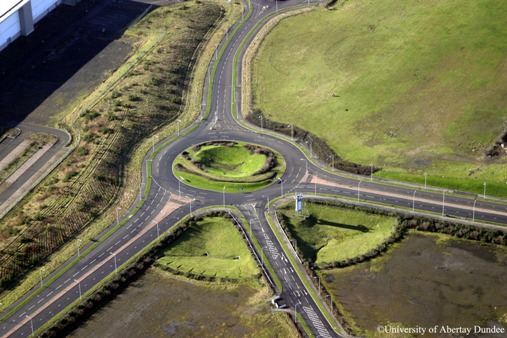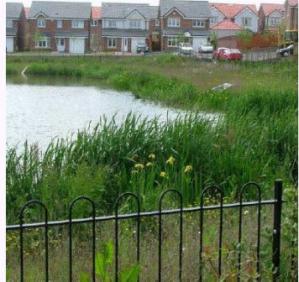Where
Location
Between Junctions 2&3 of the M90, Access from M90 Junction 3, Dunfermline, Scotland.
Description
The (DEX) is a 550ha (5.5km2) site which lies to the east of Dunfermline. The site, which was predominantly green field, will be developed over the next 20 years as a mixture of industrial, commercial, residential and recreational areas.
SEPA is primarily concerned with the quality of the runoff compromising the downstream river quality. However, the catchment immediately downstream of the site has an existing flooding problem, and SEPA are also concerned about the velocity and volume of runoff from the site. For these reasons, the use of SuDS was made a planning condition, and DEX is now the largest site in the UK to use widespread sustainable drainage methods.
|
|
|
Figure 1 Detention basin DEX Roundabout (University of Abertay/SUDSNET) |
SuDS used
DEX is located on an area of predominately low permeability clay soil. Infiltration methods have limited application on the site. Some residential roads will be served by soakaways, where soil permeability permits.
Much of the spine road system is drained using offlet kerbs, filter drains and swales, which discharge into extended detention basins and wetlands which also serve adjoining housing areas. Treatment of surface water runoff from the development and roads is achieved through a system of regional ponds and wetlands prior to discharge to the watercourses. Ponds and basins are widely used to achieve maximum attenuation of storm flows.
The wetland is located in a public park area where informal public open space adjoins an existing forested area and an area set aside for football pitches, a rugby pitch and tennis courts. Permeable paving has been used in the Tesco car park which is connected through attenuation/infiltration basins to the wetland.
How it works
The enormous size and long timescale for the development of DEX has meant that an overall SuDS design is essential. The watersheds are divided into a number of sub-catchments connecting into a spinal SuDS network of retention basins, swales, regional extended detention ponds and wetlands. Other than retention ponds related to specific sub-catchment areas, this network is already completely in place.
Some roads are drained through offlet kerbs and filter drains into large swales which provide attenuation of runoff and enhanced treatment prior to convergency to the regional treatment facilities. These drain to wetlands. Flows are attenuated and discharged at a controlled rate to the existing watercourses: the Calais Burn, Linburn, Keithing Burn and Pinkerton Burn. As well as their role in attenuating flows, SuDS are used on DEX to provide treatment.
This site is where the concept of treatment levels using fore bays, reed beds and biodegredation has been developed. Fife Council, SEPA, Scottish Water and the developer Wilcon Homes agreed that regional treatment of storm water runoff should be carried out on site. Some roads are drained via gulley pots to detention basins and others via filter drains and swales to the wetlands. Runoff from the Hyundai factory is passed through two extended detention ponds to the Calais Burn and limestone quarry ponds.
The flow from all development areas will be attenuated then treated in regional ponds, while flow from the industrial areas will be attenuated and treated within the industrial development sites. The ponds and basins are very large scale and have been deigned to hold the runoff that can be expected from up to 90% of storms occurring in a single year.
Specific details
DEX is the first site of its size and complexity to use sustainable drainage across the entire development area. It is unlikely that SuDS would have been used anywhere on the site without the planning stipulation and the support of SEPA.
|
|
|
Figure 2 Pond at Dex (Scottish Government) |
The DEX site is owned by Wilcon Homes, who are also the developers of the residential areas. Project management is carried out by Meedhurst Project Management Limited. They have played a major role in the design of the SuDS, obtaining planning and SEPA approvals and supervising the construction and installation of the principal SuDS features. Along with their clients Wilcon Homes and with the assistance of Abertay and Edinburgh Universities they will also be monitoring the effectiveness of the system in terms of attenuation and treatment over a five year period.
The cost of maintaining the systems will also be assessed during this time. Central control of the drainage strategy is vital to ensure that DEX has no detrimental effect on the catchment as a whole.
Planning and outline design of DEX started in the early 1990s, and there have been a large number of organisations involved in the planning and design processes.
Adoption issues have presented barriers to the use of SuDS on the DEX site. The highway authority were unwilling to accept responsibility for any drainage methods other than traditional piped systems or soakaways. However, they have now agreed to adopt most of the strategic road system, including the swales, filter drains, offlet kerbs and an extended detention basin in the middle of the roundabout. Fife Council are still resisting adoption of retention basins.
Many of the proposed sub-catchment developments use an attenuation basin at the bottom of a traditional piped system. Wilcon Homes as the master planners imposed a flow limit at the dischargepoint of each development sub-catchment and in some cases have provided attenuation basins to serve joint development areas. In other areas their sub-developers are required to provide the attenuation basin as part of their sub-development. Wilcon Homes themselves installed the regional system including the swales, filter drains, wetlands and treatment ponds and have used a number of innovative drainage solutions, such as using the open space in the centre of a roundabout as an extended detention basin.
DEX is a showcase site for the use of SuDS in Scotland, and it is hoped that many more good examples of SuDS will be incorporated into the site in the future.
Design & construction
DEX has been the subject of outline design and planning since the beginning of the 1990s, but detailed design of the spinal surface water drainage network started in 1995. Construction of infrastructure started in 1997, and was completed in mid 1999, with all the swales, ponds and wetlands now fully established and functioning.
Construction of the infill development is planned over the next 20 years, with a semi-conductor factory, supermarket and several housing projects already completed.
Benefits & achievements
Benefit: Planning process. The use of conventional drainage systems would have resulted in prohibitive costs to drain the development (the discharge being required via a 5km sewer to the Forth River. The use of SuDS therefore was promoted by Consultants and developer alike as a means of achieving an economic solution, which was taken up by the planners.
Barrier: Adoption. The highways authority were initially unwilling to adopt SuDS for road drainage.
Challenges & lessons learned
Safety: The local councillors were anxious about safety near open water. However, barrier planting and shallow reed planted margins have removed this apprehension.
The information on the Dunfermline Eastern Expansion was provided by:
Neil Campbell, Sir Frederick Snow and Partners (Scotland), 28 Forth Street, Edinburgh, EH1 3LH.
Jock Maxwell, Meedhurst Project Management Ltd, Sterling House, 35 High Street, Ascot, Berkshire, SL5 7HG.
Craig Berry, W.A Fairhurst and Partners (Water Services), 11 Woodide Terrace, Glasgow, G3 7XQ
Wilcon Homes Scotland Ltd, 160 Glasgow Road, Costorphine, Edinburgh, EH12 8LS





